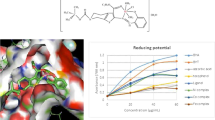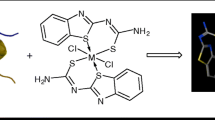Abstract
Nowadays, efforts to synthesize new compounds with medicinal activity, including antioxidant properties, have increased because they are delay, prevent, or removes oxidative damage to target cells. The interaction of these compounds with biological molecules like catalase (as an important antioxidant enzyme) is very important in the process of improving the properties of them. So, in this research two mixed-ligand complexes with divalent ion Zn containing novel Schiff base ligand of 4-pyridylimine-1,2-diacetylmonoxime as a primary ligand and 2,2-Bipyridine (bpy, in complex a) and 1,10-phenanthroline (phen, in complex b) as secondary ligands were synthesized and successfully characterized using various spectrochemical techniques. The antioxidant capacity of the synthesized complexes was studied in vitro by 2,2-diphenyl-1-picrylhydrazyl free radical scavenging method. Results revealed that the synthesized complexes presented moderate antioxidant activity compared to vitamin C (IC50(Complex a) = 0.55 mol L−1, IC50(Complex b) = 0.63 mol L−1, IC50(Vit C) = 0.045 mol L−1). Biophysical techniques were used to study the binding of these complexes with bovine liver catalase (BLC), as an antioxidant model protein. The trial findings showed the interaction between Schiff base complexes and BLC with a relatively strong binding affinity (Kb = 2.0 × 105 M−1 for complex a and 0.73 × 105 M−1 for complex b at 310 K). An intense fluorescence quenching of enzyme through a static quenching mechanism was occurred due to the binding of both complexes to BLC. Hydrogen bonds and van der Waals forces in both examined systems were the main stabilizing forces in the development of drug-protein complex. The secondary structure of BLC was changed in the presence of Zn complexes; decreased α-helix and increased β-sheet contents confirmed the protein instability during the interaction. Considering that the most important structural difference between a and b is in their secondary ligands, it can be concluded that the presence phen ligand compared to bpy leads to more interactions as well as more changes in enzyme activity.













Similar content being viewed by others
References
Q. Wang, K.-Z. Tang, W.-S. Liu, Y. Tang, M.-Y. Tan, Preparation, crystal structure and luminescent properties of the (6, 3) type network supramolecular lanthanide picrate complexes with 2, 2′-[(1, 2-naphthalene) bis (oxy)] bis [N-(phenylmethyl)] acetamide. J. Solid State Chem. 182(11), 3118–3124 (2009)
P. Das, W. Linert, Schiff base-derived homogeneous and heterogeneous palladium catalysts for the Suzuki-Miyaura reaction. Coord. Chem. Rev. 311, 1–23 (2016)
K. Maher, S. Mohammed, Metal complexes of Schiff base derived from salicylaldehyde—a review. Int. J. Curr. Res. Rev. 7(2), 6 (2015)
A.O. Sobola, G.M. Watkins, B. Van Brecht, Synthesis, characterization and antimicrobial activity of copper (II) complexes of some ortho-substituted aniline Schiff bases; crystal structure of bis (2-methoxy-6-imino) methylphenol copper (II) complex. S. Afr. J. Chem. 67(1), 45–51 (2014)
S. Shahraki, M.H. Majd, A. Heydari, Novel tetradentate Schiff base zinc (II) complex as a potential antioxidant and cancer chemotherapeutic agent: insights from the photophysical and computational approach. J. Mol. Struct. 1177, 536–544 (2019)
S. Shahraki, H.S. Delarami, Magnetic chitosan-(d-glucosimine methyl) benzaldehyde Schiff base for Pb+ 2 ion removal. Exp. Theor. Methods Carbohydr. Polym. 200, 211–220 (2018)
F. Shiri, S. Shahraki, S. Shahriari, Mechanistic understanding and binding analysis of a novel Schiff base palladium (II) complex with β-lactoglobulin and human serum albumin. J. Mol. Liq. 262, 218–229 (2018)
L. Chen, J. Zhang, Y. Zhu, Y. Zhang, Interaction of chromium (III) or chromium (VI) with catalase and its effect on the structure and function of catalase: an in vitro study. Food Chem. 244, 378–385 (2018)
D. Majumder, A. Das, C. Saha, Catalase inhibition an anti cancer property of flavonoids: a kinetic and structural evaluation. Int. J. Biol. Macromol. 104, 929–935 (2017)
M. Xu, Z. Cui, L. Zhao, S. Hu, W. Zong, R. Liu, Characterizing the binding interactions of PFOA and PFOS with catalase at the molecular level. Chemosphere 203, 360–367 (2018)
S. Shahraki, M. Saeidifar, H.S. Delarami, H. Kazemzadeh, Molecular docking and inhibitory effects of a novel cytotoxic agent with bovine liver catalase. J. Mol. Struct. 1205, 127590 (2020)
R. Ghobadi, A. Divsalar, A.R. Harifi-Mood, A.A. Saboury, M. Eslami-Moghadam, How a promising anti-cancer derivative of palladium consisting phen-imidazole ligand affects bovine liver catalase functionality. J. Photochem. Photobiol. A 364, 288–296 (2018)
J. Krych-Madej, L. Gebicka, Interactions of nitrite with catalase: enzyme activity and reaction kinetics studies. J. Inorg. Biochem. 171, 10–17 (2017)
A. Gholamian, A. Divsalar, M. Saiedifar, B. Ghalandari, A.A. Saboury, B. Koohshekan, Generation of reactive oxygen species via inhibition of liver catalase by oxalli-palladium: a spectroscopic and docking study. Process Biochem. 52, 165–173 (2017)
B. Koohshekan, A. Divsalar, M. Saiedifar, A. Saboury, B. Ghalandari, A. Gholamian, A. Seyedarabi, Protective effects of aspirin on the function of bovine liver catalase: a spectroscopy and molecular docking study. J. Mol. Liq. 218, 8–15 (2016)
J.R. Lakowicz, Principles of Fluorescence Spectroscopy, Springer (2013)
S. Shahraki, Z. Razmara, F. Shiri, A paramagnetic oxalato-bridged binuclear copper (II) complex as an effective catalase inhibitor. Spectroscopic and molecular docking studies. J. Mol. Struct. 1208, 127865 (2020)
I. Parejo, C. Codina, C. Petrakis, P. Kefalas, Evaluation of scavenging activity assessed by Co (II)/EDTA-induced luminol chemiluminescence and DPPH·(2, 2-diphenyl-1-picrylhydrazyl) free radical assay. J. Pharmacol. Toxicol. Methods 44(3), 507–512 (2000)
F. Dimiza, S. Fountoulaki, A.N. Papadopoulos, C.A. Kontogiorgis, V. Tangoulis, C.P. Raptopoulou, V. Psycharis, A. Terzis, D.P. Kessissoglou, G. Psomas, Non-steroidal antiinflammatory drug–copper (II) complexes: structure and biological perspectives. Dalton Trans. 40(34), 8555–8568 (2011)
C. Kontogiorgis, D. Hadjipavlou-Litina, Biological evaluation of several coumarin derivatives designed as possible anti-inflammatory/antioxidant agents. J. Enzyme Inhib. Med. Chem. 18(1), 63–69 (2003)
D. Singh, V. Malik, K. Kumar, C. Sharma, K. Aneja, Macrocyclic metal complexes derived from 2, 6-diaminopyridine and isatin with their antibacterial and spectroscopic studies. Spectrochim. Acta Part A Mol. Biomol. Spectrosc. 76(1), 45–49 (2010)
Z.H. Chohan, A. Munawar, C.T. Supuran, Transition metal ion complexes of Schiff-bases. Synth. Charact. Antibact. Prop. Metal Based Drugs 8(3), 137–143 (2001)
A.P. Rebolledo, G.M. de Lima, L.N. Gambi, N.L. Speziali, D.F. Maia, C.B. Pinheiro, J.D. Ardisson, M.E. Cortés, H. Beraldo, Tin (IV) complexes of 2-benzoylpyridine N (4)-phenyl-thiosemicarbazone: spectral characterization, structural studies and antifungal activity. Appl. Organomet. Chem. 17(12), 945–951 (2003)
T.N. Sorrell, C. O’Connor, O.P. Anderson, J.H. Reibenspies, Synthesis and characterization of phenolate-bridge copper dimers with a copper-copper separation of > 3.5. ANG Models for the active site of oxidized hemocyanin derivatives. J. Am. Chem. Soc. 107(14), 4199–4206 (1985)
M.F. Iskander, L. El-Sayed, N.M. Salem, R. Werner, W. Haase, Synthesis, characterization and magnetochemical studies of dicopper (II) complexes derived from bis (N-salicylidene) dicarboxylic acid dihydrazides. J. Coord. Chem. 58(2), 125–139 (2005)
H. Kabeer, S. Hanif, A. Arsalan, S. Asmat, H. Younus, M. Shakir, Structural-dependent N, O-donor imine-appended Cu (II)/Zn (II) complexes: synthesis, spectral, and in vitro pharmacological assessment, ACS Omega (2020)
H. Keypour, M. Aidi, M. Mahmoudabadi, R. Karamian, M. Asadbegy, R.W. Gable, Synthesis, X-ray crystal structural, antioxidant and antibacterial studies of new Cu (II) macroacyclic Schiff base complex with a ligand containing homopiperazine moiety. J. Mol. Struct. 1198, 126666 (2019)
A.M. Pisoschi, A. Pop, C. Cimpeanu, G. Predoi, Antioxidant capacity determination in plants and plant-derived products: A review. Oxid. Med. Cell. Longev. 2016, 1–36 (2016)
J. Krych, L. Gebicka, Catalase is inhibited by flavonoids. Int. J. Biol. Macromol. 58, 148–153 (2013)
C.D. Putnam, A.S. Arvai, Y. Bourne, J.A. Tainer, Active and inhibited human catalase structures: ligand and NADPH binding and catalytic mechanism1. J. Mol. Biol. 296(1), 295–309 (2000)
D. Wu, J. Wang, D. Liu, Y. Zhang, X. Hu, Computational and spectroscopic analysis of interaction between food colorant citrus red 2 and human serum albumin. Sci. Rep. 9(1), 1–8 (2019)
R. Yekta, G. Dehghan, S. Rashtbari, N. Sheibani, A.A. Moosavi-Movahedi, Activation of catalase by pioglitazone: multiple spectroscopic methods combined with molecular docking studies. J. Mol. Recognit. 30(12), e2648 (2017)
R. Ghobadi, A. Divsalar, A.R. Harifi-Mood, A.A. Saboury, Spectroscopic investigation of Bovine Liver Catalase interactions with a novel phen-imidazole derivative of platinum. J. Biomol. Struct. Dyn. 36(3), 656–662 (2018)
M. Bogdan, A. Pirnau, C. Floare, C. Bugeac, Binding interaction of indomethacin with human serum albumin. J. Pharm. Biomed. Anal. 47(4–5), 981–984 (2008)
Z. Sun, H. Xu, Y. Cao, F. Wang, W. Mi, Elucidating the interaction of propofol and serum albumin by spectroscopic and docking methods. J. Mol. Liq. 219, 405–410 (2016)
I. Singh, V. Luxami, K. Paul, Spectroscopy and molecular docking approach for investigation on the binding of nocodazole to human serum albumin, Spectrochim. Acta Part A Mol. Biomol. Spectrosc. 118289 (2020)
J. Liu, J. Tian, W. He, J. Xie, Z. Hu, X. Chen, Spectrofluorimetric study of the binding of daphnetin to bovine serum albumin. J. Pharm. Biomed. Anal. 35(3), 671–677 (2004)
R. Zhang, Q. Wu, R. Liu, Characterizing the binding interaction between ultrafine carbon black (UFCB) and catalase: electron microscopy and spectroscopic analysis. RSC Adv. 7(67), 42549–42558 (2017)
Acknowledgements
This work was funded by University of Zabol (Grant No. UOZGR-9618-2).
Author information
Authors and Affiliations
Corresponding authors
Supplementary Information
Below is the link to the electronic supplementary material.
Rights and permissions
About this article
Cite this article
Nouri, H., Mansouri-Torshizi, H. & Shahraki, S. Exploring the functional changes and binding mechanism of bovine liver catalase in the presence of Schiff base complexes. Comprehensive spectroscopic studies. J IRAN CHEM SOC 18, 3281–3294 (2021). https://doi.org/10.1007/s13738-021-02266-0
Received:
Accepted:
Published:
Issue Date:
DOI: https://doi.org/10.1007/s13738-021-02266-0




